 This information has been archived for reference or research purposes.
This information has been archived for reference or research purposes.
Archived Content
Information identified as archived on the Web is for reference, research or recordkeeping purposes. It has not been altered or updated after the date of archiving. Web pages that are archived on the Web are not subject to the Government of Canada Web Standards. As per the Communications Policy of the Government of Canada, you can request alternate formats on the "Contact Us" page.
Militia and Reserve Perspectives
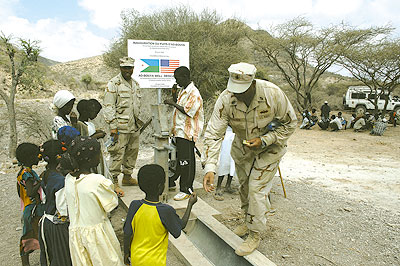
DVIDS & US Joint Combat Camera Center photo 95358 by Master Sgt Eric Kreps
Combined Joint Task Force-Horn of Africa team members during a well dedication ceremony at Ad Bouya, Djibouti. The well provides clean, potable water to people and livestock and was built by deployed members of the North Carolina Army National Guard.
Volunteers Make a Difference
by Brent C. Bankus
For more information on accessing this file, please visit our help page.
Introduction
In spite of the high operational tempo in the current world environment, the United States, in lockstep with other nations, is experiencing force reductions even though mission requirements are on the increase, for example, with respect to homeland security. However, a shortage in troop strength does not mitigate the requirement to maintain national security, given the many and varied non-state actors who remain a serious danger to the world, writ large. Additionally, local, state, and federal first responders have become challenged as mission requirements dictate an ever-widening range of contingencies of natural and man-made disasters ranging from floods and hurricanes to a large significant event, such as the terrorist attacks of 11 September 2001, and, potentially, to the threatened use of Weapons of Mass Destruction (WMDs). In order to add troop strength, the US and other nations are calling upon their home guard forces and other volunteer military organizations (VMOs) for employment as augmentation forces.
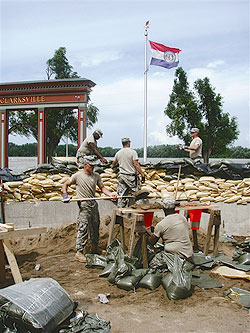
DVIDS & Office of the Secretary of Defense Public Affairs photo 94876 by Lt. Col. Ellen Krenke
Missouri National Guard soldiers fill sandbags in Clarksville, Missouri, 15 June 2008, in an effort to control flooding.
The United States
Within the United States, along with the federally sponsored US Coast Guard Auxiliary and the US Air Force Civil Air Patrol, there are member states that have an active Home Guard or State Defense Forces (SDF), and several (22 states and Puerto Rico) also possess active Naval Militias. These VMOs, much like their predecessors did during the First and Second World Wars, have as their mandate a specific focus upon homeland security and other skill sets designed to assist the first responder community.
The Home Guard concept came into being in the US before the First World War, when a preponderance of Army and Air National Guard units were called to federal service. Beginning with the Dick Act of 1903 and the National Defense Act of 1916, each organized state militia was transformed from a strictly state-funded-and-equipped force into the official second line of defence for the United States.1
As such, the organized militia, now called the National Guard, became both a state and a federal asset, and it could be called upon for a federal emergency. Thus, beginning in 1916, and then again in 1917, the National Guard was activated for federal service – first for the Mexican Border Campaign, and then for participation in the First World War.
Transforming the National Guard into a ‘dual’ force was both ‘a blessing and a curse’ for the United States. When activated for federal service, its membership absence effectively left states without the ability to cope with any natural or man-made contingencies. State governors soon petitioned the US War Department, asking for troops to act in the stead of their departed National Guard units during 1916 and 1917. Subsequently denied access to federal troop assets by the War Department, state governors were advised to re-constitute replacement units and to rename them the Home Guard. Legal authority to do so was provided by Section 61 of the 1916 National Defense Act, which stated, “...[that] nothing contained in this act shall prevent the organization and maintenance of state police or Constabulary.” Thus, by the end of the First World War in November 1918, no less than 27 states had organized, equipped, and fielded an additional 79,000 soldiers nation wide, dedicated exclusively to state service.2
The Second World War became a high point for the use of VMOs in the United States. As units of the National Guard were federalized in 1940, states were again left to their own devices to re-constitute a similar force to deal with contingencies, be they natural or manmade. Being better prepared than was the case during the First World War, President Franklin Roosevelt passed the Home Guard Act in 1940 to assist state-sponsored organizations by enabling them to make use of federal arms and equipment, when such were available. By the time of the Pearl Harbor attack on 7 December 1941, at least 13,000 state Home Guard troops were on state active duty protecting critical infrastructure sites, including arms and munitions factories and such other critical sites as power plants and strategic bridges and highways.3
By the end of the war, all but four states raised and maintained Home Guard units, and their efforts paid off in several areas; first, by providing uninterrupted service to their state by being versed in and able to fulfill their role as replacement National Guard units, and second, by enabling federalized troop strength to be better utilized in more critical areas of the war effort. Similar to their First World War counterparts, the Home Guard units of the Second World War were composed mostly of prior-service or retired-service personnel, who had, in many cases, extensive backgrounds in civil-military operations. Units were organized similarly to their National Guard counterparts, with infantry becoming the most prominent branch and the model after which most units were patterned. Additionally, these volunteer replacement units conducted training on a weekly basis, and they participated in a one-week annual training event, held usually during the summer months. Also, US Home Guard units conducted their training in a non-pay status, but often they were paid for their annual training, and sometimes, when required to attend a course of instruction, they were paid for these duties when money was available.
While these replacement units were never called upon to fulfill a combat role in addition to training for natural and man-made disasters, they also received training with respect to sabotage, small unit patrolling, and other fifth column tactics, techniques, and procedures. As National Guard units returned from federal service, these Home Guard units were disbanded in all but a few states, and they were mostly forgotten until years later.4
The US Home Guard, renamed the SDF, experienced a resurgence commencing in the 1970s as a result of Defense Secretary Laird’s implementation of a Total Force. Today, approximately 22 states and Puerto Rico still utilize SDF units in addition to the National Guard, and these units have been used in a variety of contingencies, including the relief efforts for Hurricanes Katrina and Rita.
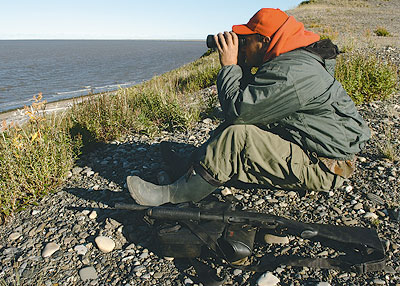
Canadian Ranger on duty.
Canadian Ranger on duty.
The Canadian Rangers
Canada’s armed forces also possessed, and still possess, a Second World War version of the Home Guard as an early warning system, with particular application in the vast expanses of the Canadian tundra. This force began as the Coastal Defence Guards, and they were later recognized as the Pacific Coast Militia Rangers (PCMR), formed in early-1942 to protect the province of British Columbia.5 Shortly after the war’s end, another group, the Canadian Rangers, was formally established in 1947. Possessing a similar mandate to their Second World War counterparts, they were and are currently responsible for protecting Canada’s sovereignty by reporting unusual activities or sightings, by collecting local data of significance to the Canadian Forces, and by conducting surveillance or sovereignty patrols when and as required. This volunteer force plays an important part in the advancement of public recognition of Canada’s First Nations and Inuit groups.
Currently, there are 4000 Rangers located in 165 communities across Canada, and by March 2008, they were projected to increase their overall strength by 800 members. There are Canadian Rangers active in all provinces and territories except Nova Scotia, Prince Edward Island, and New Brunswick. Canadian Rangers provide a military presence in the sparsely settled northern, coastal, and isolated areas of Canada that cannot be provided for conveniently or economically by other components of the Canadian Forces.6
With a motto of Vigilans (The Watchers), the mission-essential tasks of the Canadian Rangers include the reporting of unusual activities, the collecting local data of significance in support of military operations, and the conducting surveillance or presence patrols. They also assist the Canadian Forces by providing local expertise, guidance, and advice, by conducting Northern Warning System patrols, and by assisting in local search and rescue (SAR) missions. Additionally, the Rangers have proven invaluable through the reporting of unidentified vessels off the northeast coast of Quebec, through participation as observers and guides during operations to counter illegal immigration on the Canadian west coast, and through participation in disaster assistance situations, such as those of downed aircraft in the far north.7 Given their hearty lifestyle and their infinite knowledge of Canada’s vast expanses, the Rangers perform their tasks exceptionally well, and their value as an operational resource cannot be overstated.
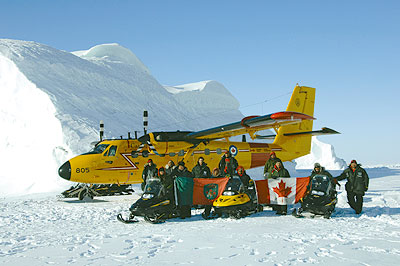
CF photo IS2008-3133
All told, the Canadian Rangers belong to one of five patrol groups, and they are organized as follows:
- The 1st Canadian Ranger Patrol Group, located in northern Canada, consisting of 58 patrols in the Yukon, the Northwest Territories, Nunavut, Alberta, Saskatchewan, and northern British Columbia;
- The 2nd Canadian Ranger Patrol Group, located in Quebec, consisting of 23 patrols;
- The 3rd Canadian Ranger Patrol Group, located in northern Ontario, consisting of 15 patrols;
- The 4th Canadian Ranger Patrol Group, located on the Pacific west coast and prairies, consisting of 38 patrols; and
- The 5th Canadian Ranger Patrol Group, located in Newfoundland and Labrador, consisting of 29 patrols.8
The Rangers have been recognized for significant and specific contributions to their communities in times of disaster, such as for providing relief after an avalanche in northern Quebec at Kangiqsualujjuaq in 1999. Additionally, much like their American counterparts in the Civil Air Patrol and Coast Guard Auxiliary who have similar cadet programs, many Canadian Rangers are involved as leaders and supervisors in their Junior Canadian Ranger (JCR) Program, established for youths of the ages 12 to 18, who are located in remote and isolated areas of Canada.9
Formal training for a Canadian Ranger is not mandatory, other than an initial 10-day orientation or ‘Boot Camp’ for new members. The 10-day training includes basic drill, rifle marksmanship, general military knowledge, navigation (map, compass, and global positioning systems), search and rescue, wilderness first aid, and radio communications.10 However, advanced training is required for Ranger Instructors and patrol leaders. Situationally dependent, Ranger training schedules are flexible and can vary from patrol to patrol, or from one area to another.
Common task training for the Rangers includes flood and fire evacuation planning, area patrols, and major air disaster assistance. Since many of the areas of responsibility are austere, there is emphasis placed upon self-sufficiency and leadership, as well as traditional skills – which are uniquely defined according to the cultural and historical practices in the local community. Periodic maintenance inspection of components of the electronic North Warning System (NWS) is another invaluable mission conducted by the Canadian Rangers, whereas other members of this proud organization conduct presence patrols in the remote and coastal areas of Canada. In terms of traditional Canadian Forces training, the Rangers are required to learn rifle marksmanship and the history and traditions of the Canadian Forces. Each Canadian Ranger is issued a .303 calibre Lee Enfield No. 4 rifle and 200 rounds of ammunition each year, along with a colourful red Ranger sweatshirt, a ball cap, and a safety vest.11
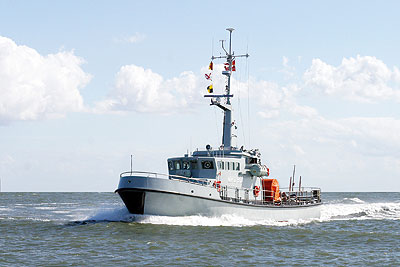
Ministry of Defence Denmark photo IMG:4825 by Lars Dalby
The Naval Home Guard works in very close cooperation with the navy and has 30 patrol vessels placed in larger ports in Denmark.
Danish Home Guard
Denmark is a Scandinavian nation that uses a home guard. The Hjemmeværnet was founded in 1949, consisting initially of many former members of the Danish resistance movement that was active during the Second World War. And the previous year of 1948 proved to be a banner year for the Danish Home Guard, as the Danish Parliament passed the Home Guard Act, the legislation that would enable the force to come into being the following year. Although they have been updated on several occasions, the fundamental principles applicable to the Danish Home Guard remain the same as they were in 1948.12
Membership in the Danish Home Guard is open to both men and women who are at least 18 years old upon application. While a military background is beneficial, it is not required, the desire to participate being the driving force for qualification. There are four branches of the Home Guard:
- The Army Home Guard – 49,000 members
- The Naval Home Guard – 4400 members
- The Air Force Home Guard – 5000 members
- The Infrastructure Home Guard – 3000 members.13
Constituting a volunteer force of approximately 61,000 personnel overall, the Home Defence Guard forces, which include 800 civilian employees and 40 naval patrol vessels, are under the command of the Home Guard Command during peacetime. The Home Guard land forces are organized in territorially defined home defence companies which, in wartime, form part of the forces of the military regions. The naval home defence force supports the navy, and the air force home defence component supports the air force Surveillance and Early Warning Group by monitoring low-altitude airspace, assisting with surveillance tasks, and so on. Simply stated, the primary mission of the Danish Home Guard is to reinforce and support the federal force – that is, the army, the navy, and the air force – in fulfilling their mandated missions. Specific mission-essential tasks assigned to the Danish Home Guard include surveillance and reporting, static guarding and securing, protection activities, and limited, uncomplicated combat operations.14
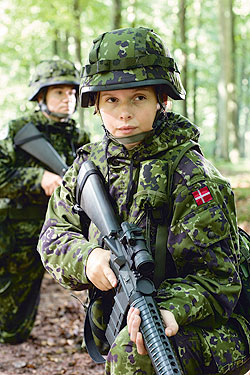
Ministry of Defence Denmark photo ZZP9S0914_b2 by Lars Dalby
Infantry training. There are approximately 50,000 members of the Danish Home Guard and nearly 15 percent are female.
With a primary focus upon military operations, the Danish Home Guard can also be activated to support the private sector. In much the same way as their counterparts in other nations, the Danish Home Guard is called upon to render assistance during natural or man-made disasters – for example, assistance to the police during national disasters, search-and-rescue operations, and so on.15 The ideological bedrock of the Home Guard is that, as a citizen, a member of the Home Guard, is able to demonstrate his right – voluntary and unpaid – to participate in the defence of his country and its democratic values.

Government Offices of Sweden. Photographer Lars Hagberg
Nordic Battle Group Force Headquarters at Enköking, Sweden.
Swedish Home Guard
Sweden is the other Scandinavian nation that uses VMOs, and it is named the Hemvärnet, or Swedish Home Guard. Similar to other nations, the Hemvärnet had its conception during the early days of the Second World War. As war clouds gathered over Europe, the Swedish Rikstag (Parliament) passed legislation formally establishing the Swedish Home Guard in May 1940. Since these units were reserve forces, they were relegated generally to simple tasks and they suffered from lack of military equipment and uniforms.16
Since that time, Sweden has maintained and enhanced its Home Guard, which, at its peak in 1986, numbered 120,000 members.17 At present, the Swedish Home Guard is experiencing a transformation, and it will be reduced from 70 battalions to 60 during 2008. Additionally, each battalion is being restructured to contain 325 soldiers, and each company of the battalion will consist of approximately 100 personnel. Also, each battalion will possess a ‘ready reaction company,’ which will possess a higher state of readiness in training, equipment, and mobility than the rest of the battalion and it will possess the ability to answer the call to emergency contingencies in minimal time.
The mission-essential tasks assigned to the Hemvärnet include verbatim:
- Guarding/protecting the infrastructure that is most vital for Sweden’s total defence, specifically, power supplies, command and communication systems, and other installations against sabotage,
- Guarding/protecting important installations at airfields and naval bases against sabotage,
- Guards/protects ammunition and mobilization depots and sensitive entry points against sabotage,
- Assisting in incident preparedness, surveillance of national territory and in civilian disaster/rescue readiness, and
- Conducting waterborne presence patrols of local archipelagos and along the Swedish coast.18
The initial perquisites to join the Swedish Home Guard include:- Must be a Swedish citizen,
- Must have completed at least 85 days of military training,
- Must be available for duty,
- Must have been cleared through Military Intelligence and Security, the police and municipal authorities.
Once accepted for service, soldiers are required to complete an introductory course of 20-40 hours, and they are obligated further to complete at least 20 training hours per year. Officers of the Home Guard are required to complete 40 to 100 hours of annual service, and commanders spend even more time ensuring the successful completion of current operations and training. Commanders of the Home Guard normally receive their training in the Swedish active forces, and they can be conscripts, reserve officers, or former career officers. Additionally, for training purposes within the Home Guard system, there is a specific National Home Guard Combat School, which is located near the capital of Stockholm.
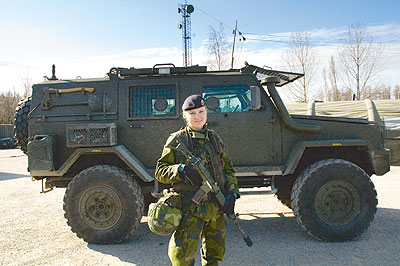
Government Offices of Sweden. Photographer Lars Hagberg
Swedish soldier of the Nordic Battle Group.
The future for the Swedish Home Guard appears to be dynamic, since, although a reduction in force is currently being experienced by the service, plans for upgrading equipment and weaponry are progressing relatively smoothly, including night vision goggles and GPS targeting systems, to name just two such initiatives. Also, new units, such as search and rescue, clearance and rescue, field engineering, medical support, nuclear, biological, and chemical (NBC) formations, and observation/surveillance units are slated to be organized and activated. Additionally, the mission task list for the Home Guard forces will place increased emphasis upon supporting civil society in peacetime, due largely to the mission requirements of aiding with forest fires, flooding, and search and rescue.19
Indian Territorial Army
Unlike the previous national examples, the volunteer Indian Territorial Army has a longer history, having been established by the British through the Indian Territorial Act of 1920. The organization was divided into two organizations, ‘The Auxiliary Force,’ for Europeans and Anglo-Indians, and ‘The Indian Territorial Force’ for Indian volunteers. After India gained its independence from Britain, the Territorial Army Act was passed in 1948, and the Territorial Army (TA) was formally inaugurated by the first Indian Governor-General, Shri C Rajagopalachari, on 9 October 1949.20
Initially, the TA was composed of various units, i.e., armoured regiments, infantry battalions, air defence units, a medical regiment, an engineers field park company, a signals regiment, and a coastal battery, to name but a few. However, with the exception of the infantry battalions, by 1972 most units had been either disbanded or incorporated into the Indian Regular Army.
The TA is thus part of the active army, and its primary role is to relieve the army from static duties, to assist civil authorities with natural or man-made contingencies, and to provide augmentation units for the active army when required to do so.21
At present, the Territorial Army consists of approximately 40,000 members, which includes departmental TA units, such as railway forces, telecommunications and general hospital personnel, and non-departmental TA units of infantry battalions (TA) and ecological battalions (TA), affiliated to various regular force infantry regiments.22
Units of the Territorial Army have been involved in national contingencies during 1962, 1965, and 1971. Additionally, the TA has also taken part in a variety of other operations, such as Operation Pawan, a peacekeeping operation in Sri Lanka during 1987, Operation Rakshak in the Punjab from May 1994 to September 1996, and Operations Rhino and Bajrang in Assam in North East India. Also, TA departmental units have aided civil authorities during labour unrest and natural contingencies, the most notable occurring during the 1991 earthquakes at Uttarkashi in Garhwal Himalaya, in 1993 at Latur in the state of Maharashtra, and during a cyclone in Orissa province. Ecological units of the TA have also been active in stemming the tide of environmental degradation by planting many trees over 20,000 hectares of land in the Mussoori Hills and Pithoragarh, in Bikaner and Jaisalmer in Rajasthan, and in the ravines of Chambal in Madhya Pradesh. In addition to these so-called ‘traditional’ operations, TA members have also taken part in various adventure activities, such as the climbing of Mount Tengchen Khang (6010 metres) in West Sikkim by a joint Indo-British TA mountaineering expedition in May 1998.23
Similar to other nations, India has established policies and procedures for joining the Territorial Army. For example, Indian nationals between 18 and 42 years of age, who have met the prescribed physical and medical standards, are eligible for an officer’s commission in the Territorial Army. In order to take advantage of an already-trained manpower pool, there is no upper age limit for ex-officers of the Regular Army wishing to join the Territorial Army. Once an individual has been screened and accepted, normally, a commission is granted in the rank of lieutenant. Former Regular Army officers are granted backdated seniority for promotion purposes.24
Conclusion
Further research suggests that the aforementioned VMOs are not an all-inclusive list of such organizations used in past or present operations. However, while they vary from country to country in size, structure, and assigned missions, unlike the United States and its collective treatment of SDFs, other nations have taken an active interest in integrating VMOs into the overall defence of the nation. That fact in and of itself is a testament to the degree of importance and confidence continually being placed upon volunteers in other nations. Since the United States military began its history as volunteers, and since it has, over time, evolved into forces of excellence in both the federal active and reserve components, it is of little wonder that some individuals question why interest in American VMOs is, by and large, an afterthought.
Additionally, other national VMOs are fully integrated with their regular forces as far as training and equipment are concerned, particularly with respect to individual and crew-served weapons familiarization and qualification. Also, since most other VMOs are integrated into the federal defence plan of their respective nations, funding for individual equipment and related ancillary equipment is not an issue, and this is certainly not the case in the United States, wherein VMOs – in particular the SDFs – are state organized and recognized.
Given that many nations are experiencing downsizing in their respective armed forces, due to a variety of financial issues, but are simultaneously experiencing an increase in mission responsibilities, particularly in the realm of homeland defence and security, fully utilizing and integrating VMOs of all types points to an intelligent and well-thought-out method of augmenting federal forces. Those who make use of VMOs have learned from history that one can never have enough troop support to deal with all contingencies, and, given the volatility and uncertainty of today’s environment, those nations utilizing VMOs should be applauded for their initiatives in this area.
![]()
Lieutenant Colonel (ret’d) Brent Bankus, US Cavalry, Army of the United States, is the Senior National Guard Advisor in the Strategic Studies Institute at the US Army War College.
Notes
- Colonel Edmund Zysk, “Stay-Behind Forces for the National Guard, Soldiers or Policemen?” unpublished thesis, U.S. Army War College, Carlisle Barracks, Carlisle, PA, 1 May 1988, p. 3.
- Barry M. Stentiford, American Home Guard – The State Militia in the Twentieth Century (College Station, TX: Texas A & M University Press, 2002), p. 51.
- Zysk, p. 8
- The Pennsylvania Guardsman Magazine, November 1948, p. 5; Pennsylvania State Archives, Harrisburg, PA.
- Canadian Rangers, available at <http://en.wikipedia.org/wiki/Canadian_Rangers>.
- Canadian Rangers, Chief of Rangers and Cadets, available at <http://www.rangers.dnd.ca/pubs/ rangers/intro_e.asp>.
- Ibid.
- See the official site of the Rangers at: <http://www.army.forces.gc.ca/1f/Francais/7_5_1_1.asp>.
- Chief of Reserves and Cadets, About the Junior Canadian Ranger Program, available at <http://www.rangers.forces.gc.ca/pubs/jcr/intro_e.asp>.
- Third Canadian Ranger Patrol Group, A Proud History and Important Role, available at <http://www.army.dnd.ca/3crpg/English/history/history_e.shtm>.
- Ibid.
- Hjemmeværnet, the Danish Home Guard, available at <http://www.hjv.dk/Eng/forside_engelsk.htm>.
- Denmark, Official Denmark Defence and Military, available at <http://www.um.dk/Publikationer?UM/ English/Denmark/kap 1/1-13-7.asp>. See also: <http://forsvaret.dk/FMN/engl>.
- Ibid.
- Forsvarministeriet, Ministry of Defence Denmark, available at <http://forsvaret.dk/FMN/eng/ Total+Defence/The+Danish+Home+Guard/>.
- Swedish Armed Forces, History, available at <http://www.hemvarnet.mil.se/ article.php?c=art&id=13702&do=print>.
- Ibid.
- Swedish Armed Forces, NHG Today, available at <http://www.hemvarnet.mil.se/ article.php?id=13706&lang=E>.
- Swedish Armed Forces, NHG Tomorrow. Available at <http://www.hemvarnet.mil.se/ article.php?id=13705&lang=E>.
- Indian Army, Territorial Army, available at <http://indianarmy.nic/arta1.htm>. See also: <http://www.indianarmy.gov.in/ta/territorial_army.html>.
- Territorial Army, available at <http://bharat-rakshak.com/LAND-FORCES/Army/TA.html>.
- Ibid.
- Indian Army; Territorial Army; History, also available at <http://indianarmy.nic.in/artal1.htm>.
- Ibid.
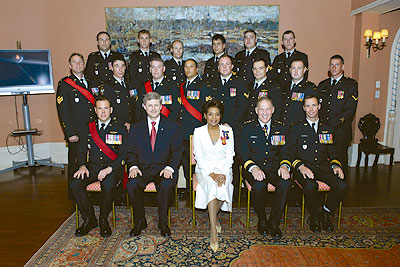
MCpl Serge Gouin, Rideau Hall
Her Excellency the Right Honourable Michaëlle Jean, Governor General of Canada, the Prime Minister, the Right Honourable Stephen Harper, and Lieutenant-General Walter Natynczyk, then-CDS Designate, with Military Valour Decoration recipients at the unveiling of the official Canadian Victoria Cross medal in the ballroom of Rideau Hall on May 16, 2008. The attending MVD recipients were Major David Nelson Quick, SMV, CD, Sergeant Patrick Tower, SMV, CD, Sergeant Michael Thomas Victor Denine, MMV, CD, Private Shane Aaron Bradley Dolmovic, MMV, Sergeant Derek John Scott Fawcett, MMV, CD, Master Corporal Collin Ryan Fitzgerald, MMV, Sergeant Gerald Alexander Killam, MMV, CD, Corporal John David Makela, MMV, Master Corporal Sean Hubert Niefer, MMV, Corporal Michael Patrick O’Rourke, MMV, Corporal Clinton John Orr, MMV, Captain Derek Prohar, MMV, Captain Michael John Reekie, MMV, Private Jay James Renaud, MMV, Corporal Joseph Jason Lee Ruffolo, MMV, and Major Michael Charles Wright, MMV, MSM, CD.






